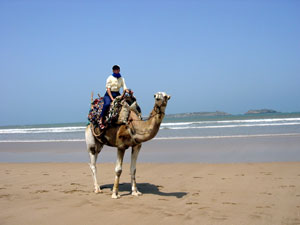Published in the Ocean Watch column, Honolulu Star-Advertiser © Susan Scott
July 04, 2003
From the moment I saw “Casablanca” on late-night TV, I wanted to visit Morocco. Later, I wanted to go to there because I loved the Crosby, Stills & Nash song “Marrakesh Express.”
Over the years, I learned about the Berbers of the Atlas Mountains, the Bedouins of the Sahara and the rich marine life of the Atlantic coast, and my love affair with this North African country grew to mystical proportions. Morocco became so fantastic in my mind, I almost didn’t want to go there. What if reality spoiled all those years of romantic images?
It didn’t. Having just spent a month there, I am happy to report that Morocco surpassed my wildest dreams, including my more recent ones of finding unusual marine creatures.
I found marine animals just about everywhere in Morocco, including the deserts and mountains. OK, the ones there were long dead, but that’s what made them great. Morocco is loaded with marine fossils, so loaded, in fact, that after a while I found myself casually trodding on trilobites and ho-humming over ammonites the size of dinner plates.
And speaking of dinner plates, I spent much time sliding mine around to better view the nautiloidea embedded in restaurants’ stone tabletops. The tables there were as good as the food.
People sold fossils nearly everywhere. One man’s extensive roadside collection stopped me, and almost immediately the haggling began. After settling on a price for three large, perfect, petrified snails, my husband pulled me aside. “I think this guy made these,” he said.
Indeed, two of my three “fossils” had been carved. We gave the guy credit for creativity and bought them anyway.
Other kinds of snails are a colorful part of Morocco’s ancient history. Just off the coast of a picturesque coastal town called Essaouira lay the Isles Purpuraires, famous for their murexes. These familiar mollusks have lovely spiral shells covered with spikes and projections. Some murex species, especially the ones in this area, produce a purple excretion once coveted for dye.
In the first century B.C., the Roman ruler Juba II built a purple dye factory in the Isles Purpuraires. This factory became famous throughout the Roman Empire, where only emperors were allowed to wear clothing dyed this color. That’s why when Juba’s son, Ptolemy, wore a purple toga to a party, people saw red. Rome’s third emperor, Caligula, murdered Ptolemy for his arrogance.
Essaouira is also famous for fishing, thanks to the tradewinds there creating cold-water upwelling off the Atlantic coast. Moroccan waters host about 240 species of fish, many commercially valuable. The most famous of these are sardines, which Morocco exports all over the world.
Morocco’s fishing industry is a mixture of modern and traditional methods. In the shipyards of Essaouira, boat builders still make traditional-style trawlers from teak and eucalyptus. Their tools are modern but the designs are ancient.
Near these boatyards, chefs beckon tourists to come eat at their seafood stands, and nearby, people offered something I always dreamed of: camel rides on a beautiful Moroccan beach. Neither was a hard sell.

Click on picture to enlarge it.
I loved Morocco but I’m glad to be home. Hawaii is the other place that surpasses my dreams.